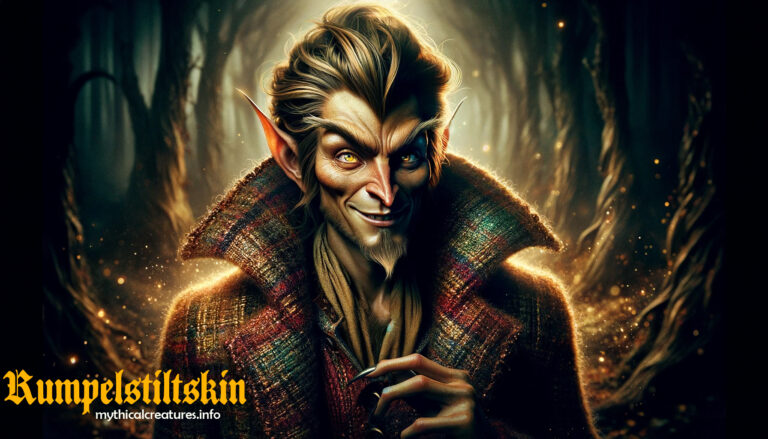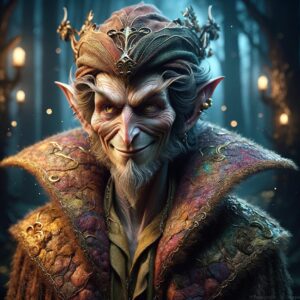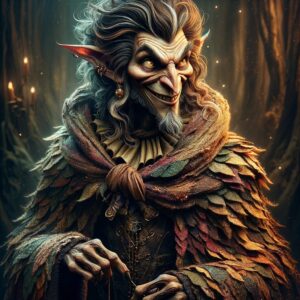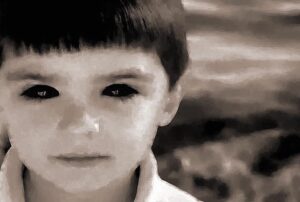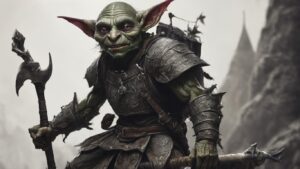Table of Contents
In the story, Rumpelstiltskin is a mysterious and magical little man who helps a miller’s daughter spin straw into gold for the king, who has demanded this task be completed or else she will face dire consequences. Rumpelstiltskin assists the girl for three nights, each time demanding something valuable in return, such as her necklace and her firstborn child.
Eventually, the clever miller’s daughter discovers Rumpelstiltskin’s true name, which gives her power over him. When he returns to claim her child, she reveals his name, causing him to become furious and eventually flee, thus breaking the curse.
The story of Rumpelstiltskin is a classic fairy tale that highlights themes of cleverness, the importance of keeping promises, and the consequences of making deals with magical creatures. It has been adapted and retold in various forms in literature, theater, and film over the years.
The origin of the Rumpelstiltskin story can be traced back to German folklore. It was popularized and made widely known through the collection of fairy tales by the Brothers Grimm, Jacob and Wilhelm Grimm, in the early 19th century. The Brothers Grimm collected and published numerous traditional folktales in their famous work “Grimm’s Fairy Tales” (Grimms’ Märchen), first published in 1812.
While the Brothers Grimm are credited with popularizing the story, Rumpelstiltskin likely existed in oral folklore for centuries before their time. Folktales like these often have ancient roots and evolve over time as they are passed down through generations.
The character of Rumpelstiltskin and the themes of the story are common in European folklore, where magical beings or creatures often play a role in tales of cleverness and resourcefulness.
Physical Description
The physical description of Rumpelstiltskin can vary in different adaptations and illustrations, but there is some common characteristics associated with the character as described in the original Brothers Grimm fairy tale:
Small Stature: Rumpelstiltskin is typically depicted as a very small man, often no taller than a child or dwarf.
Odd Clothing: He is often described as wearing unusual or tattered clothing, which adds to his mysterious and otherworldly appearance.
Aged Appearance: Despite his small size, Rumpelstiltskin may be portrayed as having a somewhat aged or wrinkled face, giving him a somewhat old and wizened appearance.
Magical Features: Depending on the adaptation, Rumpelstiltskin may have magical or supernatural features, such as a pointed hat, pointy shoes, or other elements that emphasize his mystical nature.
Cunning Expression: His facial expression is often depicted as sly, mischievous, or cunning, reflecting his clever and tricky personality.
Rumpelstiltskin’s personality is typically characterized by a combination of cunning, trickery, and a certain degree of malevolence, especially in the context of the traditional fairy tale. Common personality traits associated with Rumpelstiltskin:
Cleverness: Rumpelstiltskin is known for his cleverness and resourcefulness. He is able to help the miller’s daughter spin straw into gold, but his assistance comes at a price.
Mysterious: He is a mysterious and enigmatic character who appears seemingly out of nowhere and offers his assistance in exchange for something valuable.
Manipulative: Rumpelstiltskin often manipulates and takes advantage of the desperation and vulnerability of others, such as the miller’s daughter and the king.
Bargain-Maker: He is a skilled negotiator and bargainer, striking deals with those in need. However, these deals often have consequences that catch his clients off guard.
Vindictive: In the original Grimm Brothers’ version of the story, Rumpelstiltskin becomes angry when his true name is discovered and responds with anger and vindictiveness.
Magical: Rumpelstiltskin possesses magical abilities, allowing him to perform feats like turning straw into gold. His magical nature adds an element of fantasy and wonder to the story.
Special Abilities
Rumpelstiltskin is often depicted as a magical and supernatural character in the traditional fairy tale, and he possesses several special abilities or powers that play a central role in the story:
Spinning Straw into Gold: Rumpelstiltskin’s most famous and central ability is the power to spin straw into gold. In the fairy tale, he assists the miller’s daughter by performing this remarkable feat over three nights in exchange for increasingly valuable rewards.
Knowledge of Hidden Names: Rumpelstiltskin has a secret name that he guards closely, and he is aware of the power associated with knowing someone’s true name. This knowledge allows him to maintain control over his bargains and the terms of his deals.
Disappearing Act: In some adaptations, Rumpelstiltskin can vanish or disappear at will, adding to his mysterious and elusive nature. This ability makes it difficult for others to track him down once they have made agreements with him.
Shapeshifting: While not a common feature in all versions of the tale, some adaptations depict Rumpelstiltskin as a shapeshifter who can change his appearance to deceive or elude others.
Magical Objects: In certain adaptations, Rumpelstiltskin may possess magical objects or tools that aid him in his tasks or add to his mystical aura.
In modern usage and symbolism, Rumpelstiltskin continues to serve as a well-known character from folklore with various interpretations and meanings. Some ways in which Rumpelstiltskin is relevant in modern contexts:
Symbol of Cleverness and Resourcefulness: Rumpelstiltskin is often seen as a symbol of cleverness, resourcefulness, and quick thinking. His ability to solve seemingly impossible problems, such as spinning straw into gold, can be a metaphor for finding creative solutions to real-life challenges.
Cautionary Tale: The Rumpelstiltskin story can be used as a cautionary tale about the consequences of making hasty or desperate deals without fully understanding the terms. It emphasizes the importance of careful consideration before entering into agreements.
Themes of Identity and Secrets: Rumpelstiltskin’s secret name and the power associated with it can symbolize the importance of personal identity and the consequences of revealing one’s true self. In modern contexts, this can be applied to themes of privacy and online anonymity.
Fairy Tale Adaptations: Rumpelstiltskin has been adapted into various modern works of literature, film, and television, often with updated themes and settings. These adaptations may explore contemporary issues while still drawing on the character’s traditional traits.
Economic and Financial Symbolism: Some interpretations of the story link it to economic and financial themes. Rumpelstiltskin’s ability to turn straw into gold can symbolize the allure of quick wealth and the dangers of financial speculation.
Metaphor for Hidden Talents: Rumpelstiltskin’s ability to spin straw into gold may also be seen as a metaphor for recognizing and harnessing one’s hidden talents and abilities.
Pop Culture References: Rumpelstiltskin occasionally appears in popular culture, such as in literature, art, and advertising, as a recognizable and intriguing character.
In summary, Rumpelstiltskin remains relevant in modern usage and symbolism as a character that can be interpreted in various ways, representing themes of cleverness, identity, caution, and resourcefulness. The story continues to resonate with audiences as it is adapted and reimagined to address contemporary issues and challenges.
Ralated and similar creatures
Several folkloric and mythological creatures share similarities with Rumpelstiltskin in terms of their magical abilities, trickster nature, or role in folklore. Here are a few related and similar creatures:
Tom Tit Tot (England): Tom Tit Tot is a character from English folklore who bears similarities to Rumpelstiltskin. Like Rumpelstiltskin, he helps a young woman spin straw into gold in exchange for progressively valuable items. The story is similar to the Rumpelstiltskin tale but with its own variations.
Puck (English and Celtic): Puck, also known as Robin Goodfellow, is a mischievous and often helpful fairy or sprite found in English and Celtic folklore. He is known for playing pranks and tricks on humans, but he can also be a benevolent and helpful figure. Puck appears in Shakespeare’s “A Midsummer Night’s Dream.”
Loki (Norse Mythology): Loki is a complex figure in Norse mythology known for his cunning and trickster nature. While he is not directly comparable to Rumpelstiltskin, Loki shares the archetype of a trickster in mythology and often causes both chaos and solutions to problems.
Kokopelli (Native American): Kokopelli is a fertility deity and trickster figure in the folklore of various Native American tribes, particularly in the southwestern United States. He is often depicted as a humpbacked flute player who brings music, fertility, and mischief.
Anansi the Spider (African and Caribbean): Anansi is a trickster character in African and Caribbean folklore, particularly among the Ashanti people of West Africa and in African diaspora communities. Anansi is known for his cunning and cleverness, often using trickery to outsmart stronger foes.
Kitsune (Japanese): Kitsune are fox spirits in Japanese folklore known for their shape-shifting abilities and mischievous nature. They can be benevolent or malevolent and often interact with humans, sometimes offering aid or causing trouble.
Br’er Rabbit (African American and Southern United States): Br’er Rabbit is a trickster character from African American and Southern United States folklore, often featured in the Uncle Remus stories. Similar to Rumpelstiltskin, Br’er Rabbit uses his cleverness to outwit others.
